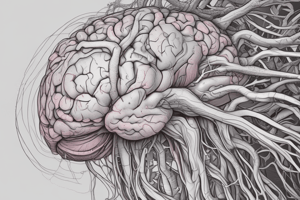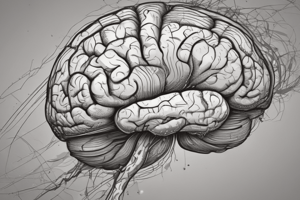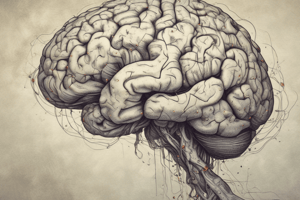Podcast
Questions and Answers
Which part of the brain contains more than half of all brain neurons?
Which part of the brain contains more than half of all brain neurons?
- Cerebrum
- Cerebellum (correct)
- Thalamus
- Hypothalamus
Which cells are the most abundant type of neuron in the entire brain?
Which cells are the most abundant type of neuron in the entire brain?
- Bipolar cells
- Pyramidal cells
- Granule cells (correct)
- Purkinje cells
What is the function of the thalamus in motor control?
What is the function of the thalamus in motor control?
- Controls hormone secretion
- Influences heart rate
- Relays signals from cerebellum to cerebrum (correct)
- Processes information on its way to the cerebral cortex
Which part of the brain is the major control center of the autonomic nervous system and the endocrine system?
Which part of the brain is the major control center of the autonomic nervous system and the endocrine system?
Which part of the brain is the most rostral part of the brainstem?
Which part of the brain is the most rostral part of the brainstem?
What is the main function of the cerebellar peduncles?
What is the main function of the cerebellar peduncles?
Which part of the brain processes information on its way to the cerebral cortex and screens out most of the information it receives?
Which part of the brain processes information on its way to the cerebral cortex and screens out most of the information it receives?
Which part of the brain is involved in memory, emotion, and plays a key role in motor control?
Which part of the brain is involved in memory, emotion, and plays a key role in motor control?
Which part of the brain attaches to the pituitary through a stalk-like structure called the infundibulum?
Which part of the brain attaches to the pituitary through a stalk-like structure called the infundibulum?
Which part of the brain constitutes about four-fifths of the diencephalon and is perched at the superior end of the brainstem beneath the cerebral hemispheres?
Which part of the brain constitutes about four-fifths of the diencephalon and is perched at the superior end of the brainstem beneath the cerebral hemispheres?
Which part of the brain extends anteriorly to the optic chiasm and posteriorly to the mammillary bodies?
Which part of the brain extends anteriorly to the optic chiasm and posteriorly to the mammillary bodies?
Which part of the brain contains at least 23 nuclei within five major groups and is the gateway to the cerebral cortex?
Which part of the brain contains at least 23 nuclei within five major groups and is the gateway to the cerebral cortex?
Which brain structure is primarily responsible for sensory perception, memory, thought, and voluntary motor actions?
Which brain structure is primarily responsible for sensory perception, memory, thought, and voluntary motor actions?
What is the primary function of the limbic system?
What is the primary function of the limbic system?
Which brain structures are involved in motor control?
Which brain structures are involved in motor control?
What is responsible for processing cognition in the brain?
What is responsible for processing cognition in the brain?
Which brain structures are involved in memory processes?
Which brain structures are involved in memory processes?
What brain regions are responsible for components of language, such as reading, writing, speaking, and understanding words?
What brain regions are responsible for components of language, such as reading, writing, speaking, and understanding words?
What is correlated with cerebral lateralization?
What is correlated with cerebral lateralization?
Which brain structure regulates body temperature and activates mechanisms accordingly?
Which brain structure regulates body temperature and activates mechanisms accordingly?
What is the composition of the cerebral white matter?
What is the composition of the cerebral white matter?
Which brain structures are involved in emotional feelings and memories?
Which brain structures are involved in emotional feelings and memories?
Which brain regions process sensation?
Which brain regions process sensation?
What regulates motor control in the brain?
What regulates motor control in the brain?
What is the primary function of the cerebellum?
What is the primary function of the cerebellum?
Which part of the brain is the major control center of the autonomic nervous system and the endocrine system?
Which part of the brain is the major control center of the autonomic nervous system and the endocrine system?
What is the composition of the forebrain?
What is the composition of the forebrain?
Which brain structure attaches to the pituitary through a stalk-like structure called the infundibulum?
Which brain structure attaches to the pituitary through a stalk-like structure called the infundibulum?
What is the function of the thalamus in motor control?
What is the function of the thalamus in motor control?
Which part of the brain contains more than half of all brain neurons?
Which part of the brain contains more than half of all brain neurons?
What brain region constitutes about four-fifths of the diencephalon and is perched at the superior end of the brainstem beneath the cerebral hemispheres?
What brain region constitutes about four-fifths of the diencephalon and is perched at the superior end of the brainstem beneath the cerebral hemispheres?
Which part of the brain extends anteriorly to the optic chiasm and posteriorly to the mammillary bodies?
Which part of the brain extends anteriorly to the optic chiasm and posteriorly to the mammillary bodies?
What is the primary function of the limbic system?
What is the primary function of the limbic system?
Which cells are the most abundant type of neuron in the entire brain?
Which cells are the most abundant type of neuron in the entire brain?
What is the function of the cerebellar peduncles?
What is the function of the cerebellar peduncles?
What are the components of the forebrain?
What are the components of the forebrain?
Which part of the brain is primarily responsible for sensory perception, memory, thought, and voluntary motor actions?
Which part of the brain is primarily responsible for sensory perception, memory, thought, and voluntary motor actions?
What is the main function of the limbic system?
What is the main function of the limbic system?
Which brain structure is involved in motor control?
Which brain structure is involved in motor control?
What regulates motor control in the brain?
What regulates motor control in the brain?
Which brain regions are involved in emotional feelings and memories?
Which brain regions are involved in emotional feelings and memories?
Which part of the brain is involved in memory, emotion, and plays a key role in motor control?
Which part of the brain is involved in memory, emotion, and plays a key role in motor control?
What is correlated with cerebral lateralization?
What is correlated with cerebral lateralization?
Which brain structure contains at least 23 nuclei within five major groups and is the gateway to the cerebral cortex?
Which brain structure contains at least 23 nuclei within five major groups and is the gateway to the cerebral cortex?
What is the composition of the cerebral white matter?
What is the composition of the cerebral white matter?
What brain regions are responsible for components of language, such as reading, writing, speaking, and understanding words?
What brain regions are responsible for components of language, such as reading, writing, speaking, and understanding words?
What is the function of the thalamus in motor control?
What is the function of the thalamus in motor control?
Which part of the brain extends anteriorly to the optic chiasm and posteriorly to the mammillary bodies?
Which part of the brain extends anteriorly to the optic chiasm and posteriorly to the mammillary bodies?
Flashcards are hidden until you start studying
Study Notes
The Human Brain: Anatomy and Function
- The hypothalamic thermostat regulates body temperature and activates mechanisms accordingly
- The cerebrum is the largest part of the human brain and is responsible for sensory perception, memory, thought, and voluntary motor actions
- The cerebral white matter is composed of glia and myelinated nerve fibers that transmit signals through three types of tracts
- The limbic system is an important center of emotion and learning, with prominent components including the cingulate gyrus, hippocampus, and amygdala
- The basal nuclei, including the caudate nucleus, putamen, and globus pallidus, are involved in motor control
- Processing cognition involves widely distributed association areas of the cerebral cortex, which make up about 75% of all brain tissue
- Memory involves learning, storage, and retrieval processes and is managed by brain structures such as the hippocampus, cerebellum, and amygdala
- Emotional feelings and memories involve interactions between the prefrontal cortex, diencephalon, hypothalamus, and amygdala
- Sensation is processed by primary sensory cortex and association areas, with special senses like vision, hearing, equilibrium, taste, and smell each having dedicated cortical regions
- Motor control is regulated by the primary motor cortex, precentral gyrus, upper motor neurons, basal nuclei, and cerebellum
- Different brain regions are responsible for components of language, such as reading, writing, speaking, and understanding words
- Cerebral lateralization, the difference in structure and function between the two cerebral hemispheres, is correlated with handedness, age, and sex, with the left hemisphere usually the categorical hemisphere and the right hemisphere the representational hemisphere.
The Human Brain: Anatomy and Function
- The hypothalamic thermostat regulates body temperature and activates mechanisms accordingly
- The cerebrum is the largest part of the human brain and is responsible for sensory perception, memory, thought, and voluntary motor actions
- The cerebral white matter is composed of glia and myelinated nerve fibers that transmit signals through three types of tracts
- The limbic system is an important center of emotion and learning, with prominent components including the cingulate gyrus, hippocampus, and amygdala
- The basal nuclei, including the caudate nucleus, putamen, and globus pallidus, are involved in motor control
- Processing cognition involves widely distributed association areas of the cerebral cortex, which make up about 75% of all brain tissue
- Memory involves learning, storage, and retrieval processes and is managed by brain structures such as the hippocampus, cerebellum, and amygdala
- Emotional feelings and memories involve interactions between the prefrontal cortex, diencephalon, hypothalamus, and amygdala
- Sensation is processed by primary sensory cortex and association areas, with special senses like vision, hearing, equilibrium, taste, and smell each having dedicated cortical regions
- Motor control is regulated by the primary motor cortex, precentral gyrus, upper motor neurons, basal nuclei, and cerebellum
- Different brain regions are responsible for components of language, such as reading, writing, speaking, and understanding words
- Cerebral lateralization, the difference in structure and function between the two cerebral hemispheres, is correlated with handedness, age, and sex, with the left hemisphere usually the categorical hemisphere and the right hemisphere the representational hemisphere.
Studying That Suits You
Use AI to generate personalized quizzes and flashcards to suit your learning preferences.



